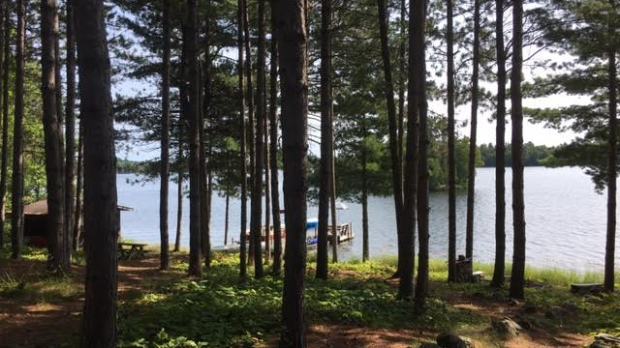“Boy, look at that view,” I said.
He smiled.
The thin trunks of impossibly tall pine trees speckled the down-sloping hill to the northern Minnesota lake below.
“These trees were only saplings when I was about four. Years ago, a tornado cleared out most of the existing trees and I remember my dad walking around with me and pointing to one spot saying, ‘Put one here,’ and then another, ‘Put one there.'”
Now, the trees towered over us as we wrenched our necks looking at their tips. Forty-six years had passed.
As we walked the rock-rimmed path from the cabin to the lake, the dried pine needles crunched under our feet.
“I spent a year-and-a-half propping a sliding ladder against each tree and trimming branch after branch with a chainsaw. At times, I can’t believe I didn’t fall and break my neck.”
Each pine tree was neat and without branches a good twenty feet off the ground. As a result, you could see through to the serene lake water lapping against the shore. It was such a stark contrast to the other side of the cabin where, peering through the pine forest, your vision was clouded by a tangled web of young branches and starbursts of needles.
“Ever since I did that, I have asked my kids to simply grab a handful of branches laying about the path as they walk up from the dock to the cabin just so the path stays clear.”
The path had absolutely no branches.
“They’ve done a pretty good job,” I smiled.
Then he looked me square in the eye.
“It’s funny, Tod. If the branches were scattered on the path, you would notice them. Not a good thing. The path would seem cluttered. But my hope is to put in the work so you don’t notice them. The same goes for trimming the trees. Your view of the lake would be impaired if the lower branches were still there. But instead, you can now look with no attention to lower branches that would block your view, but instead find a clear vision of a beautiful lake. The better job I do, the less you notice it.” “If I can teach my kids one thing about this cabin, it is to leave it better for those who come after you.”
Wow.
My friend fits into the category of “larger than life.” Witty, winsome, exceedingly generous, yet he is also “old school.” His cabin is adorned with family pictures (from many generations), classic books, signs outside the sauna that will make you laugh out loud, and mementos (like a glass-encased collection of old family fishing lures or a World War I portrait of a grandfather in the Marines) that accompanied by his story-telling can move you. He has countless DVDs and videotapes for family movie nights purchased from Goodwill of classics like Mr. Ed, Hoosiers or Patch Adams (it is largely a social media-free zone and no cable television). And he and his family will annually watch a 2003 video called Alone in the Wilderness about a widower who went to Alaska and built everything – I mean everything – by hand with the aid of old-fashioned grit, determination and a refreshing humility. His wife is an extraordinarily gifted woman who operates a balancing act between work and home with unfailing grace. And his kids engage in thoughtful conversation, look you in the eye when talking with you and despite our protestations, called my wife and me “Mr. and Mrs. Worner” throughout our stay.
Ostensibly, I went to this lake cabin to relax and enjoy time with friends and family.
But do you know what? I learned a thing or two:
For beautiful things to grow, someone has to plant them. We are custodians, not owners of all that we have. Respect this and preserve accordingly. Don’t ever – ever – forget the unrecognized thought and considerable effort that went into all you are currently enjoying. Sometimes, the better job someone did, the less you notice it. Be aware and be grateful. Be a little “old school.” Even more than discipline, a strong work ethic teaches values. Preserve memories by telling the story.
“Boy, look at that view.”
Indeed.
Look at that view.
Photo credit: Me

